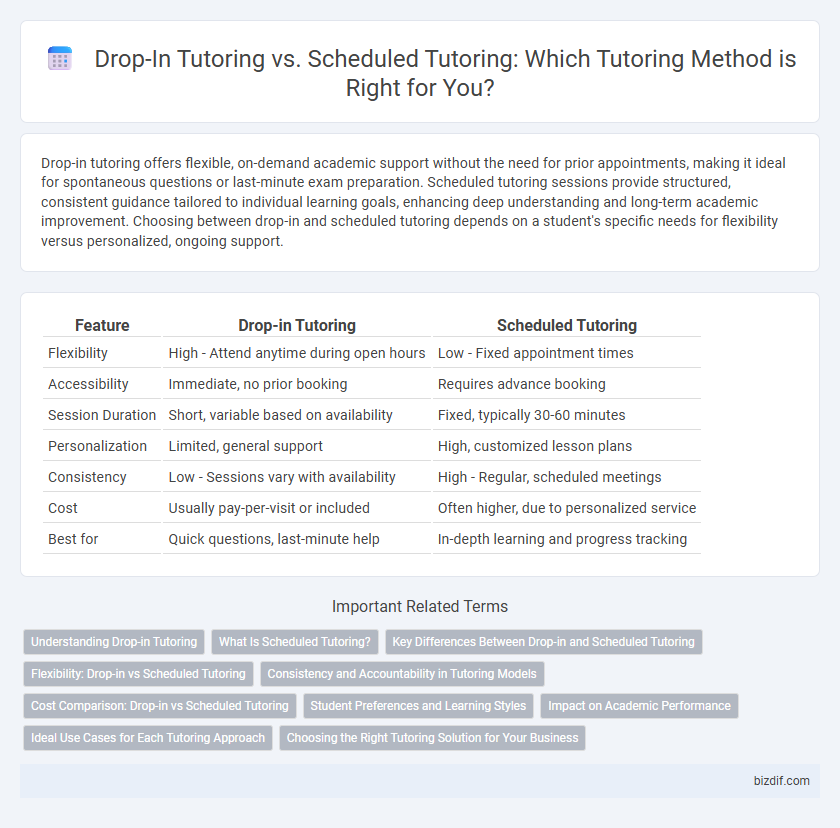Drop-in tutoring offers flexible, on-demand academic support without the need for prior appointments, making it ideal for spontaneous questions or last-minute exam preparation. Scheduled tutoring sessions provide structured, consistent guidance tailored to individual learning goals, enhancing deep understanding and long-term academic improvement. Choosing between drop-in and scheduled tutoring depends on a student's specific needs for flexibility versus personalized, ongoing support.
Table of Comparison
| Feature | Drop-in Tutoring | Scheduled Tutoring |
|---|---|---|
| Flexibility | High - Attend anytime during open hours | Low - Fixed appointment times |
| Accessibility | Immediate, no prior booking | Requires advance booking |
| Session Duration | Short, variable based on availability | Fixed, typically 30-60 minutes |
| Personalization | Limited, general support | High, customized lesson plans |
| Consistency | Low - Sessions vary with availability | High - Regular, scheduled meetings |
| Cost | Usually pay-per-visit or included | Often higher, due to personalized service |
| Best for | Quick questions, last-minute help | In-depth learning and progress tracking |
Understanding Drop-in Tutoring
Drop-in tutoring offers flexible, on-demand academic help without prior appointments, allowing students to receive immediate assistance tailored to their urgent needs. This approach supports quick clarification of concepts and problem-solving during peak study times, making it ideal for last-minute questions or strengthening specific topics. Accessibility and convenience are enhanced, as learners can drop in based on their schedules, fostering a responsive and student-centered learning environment.
What Is Scheduled Tutoring?
Scheduled tutoring involves booking specific, pre-arranged sessions with a tutor at agreed-upon times, ensuring consistent and focused learning tailored to individual needs. This method allows for personalized lesson planning, progress tracking, and dedicated time slots that fit the student's availability. Many students prefer scheduled tutoring for its structured approach, fostering accountability and deeper subject comprehension over time.
Key Differences Between Drop-in and Scheduled Tutoring
Drop-in tutoring offers flexible, on-demand assistance ideal for students needing immediate help without prior appointment, while scheduled tutoring requires booking sessions in advance for structured, consistent learning. Drop-in sessions emphasize accessibility and spontaneity but may lack personalized continuity, whereas scheduled tutoring provides tailored, ongoing support focused on specific academic goals. The key difference lies in the balance between convenience and customized guidance, influencing student engagement and learning outcomes.
Flexibility: Drop-in vs Scheduled Tutoring
Drop-in tutoring offers maximum flexibility by allowing students to access help whenever they need it without prior appointments, ideal for spontaneous questions or last-minute study sessions. Scheduled tutoring provides structured, consistent support tailored to a student's specific time availability and learning goals, promoting thorough preparation and deeper understanding. Choosing between drop-in and scheduled tutoring depends on a student's preference for on-demand assistance versus planned, regular engagement.
Consistency and Accountability in Tutoring Models
Scheduled tutoring fosters consistency by setting fixed sessions that encourage regular study habits and long-term academic improvement. Drop-in tutoring offers flexibility but may lack the accountability and structured progression needed for sustained skill development. Students committed to steady progress often benefit more from the predictable routine and personalized goals in scheduled tutoring.
Cost Comparison: Drop-in vs Scheduled Tutoring
Drop-in tutoring sessions typically cost less per visit due to their flexible, on-demand nature, making them ideal for students needing occasional, brief assistance. Scheduled tutoring often involves higher fees as it guarantees dedicated, consistent time with a tutor, offering a structured learning plan tailored to individual academic goals. Comparing costs, drop-in tutoring provides budget-friendly access but may lack the continuity and depth afforded by scheduled sessions.
Student Preferences and Learning Styles
Drop-in tutoring offers flexibility for students who prefer spontaneous help and have variable schedules, allowing them to address questions as they arise. Scheduled tutoring caters to learners who benefit from structured, consistent sessions, promoting deeper understanding through routine and preparation. Student preferences often align with their learning styles, as visual or kinesthetic learners may favor scheduled sessions for focused practice, while auditory learners might thrive with the dynamic interaction of drop-in support.
Impact on Academic Performance
Drop-in tutoring offers flexible, immediate help that addresses urgent questions, which can lead to quick improvements in understanding and problem-solving skills, especially during high-stress periods like exams. Scheduled tutoring provides consistent, structured support that helps reinforce foundational concepts and develop long-term academic habits, resulting in sustained performance gains over time. Both methods enhance academic outcomes, but scheduled tutoring more significantly impacts continuous learning and retention.
Ideal Use Cases for Each Tutoring Approach
Drop-in tutoring is ideal for students seeking immediate help with specific questions or last-minute assignments, providing flexible, on-demand support without the need for advance booking. Scheduled tutoring suits learners requiring consistent, structured guidance over time, enabling tutors to tailor lessons to individual progress and long-term academic goals. Both approaches serve distinct needs, with drop-in fostering quick problem-solving and scheduled sessions promoting comprehensive understanding.
Choosing the Right Tutoring Solution for Your Business
Drop-in tutoring offers flexible access for students needing immediate, on-demand assistance, making it ideal for businesses aiming to accommodate varying customer schedules and peak times. Scheduled tutoring provides structured, consistent sessions that foster deeper learning relationships and progress tracking, which benefits tutoring centers focused on long-term student success and retention. Selecting the right tutoring solution depends on aligning service delivery with your business goals, client preferences, and operational capacities to optimize both student outcomes and resource management.
Drop-in Tutoring vs Scheduled Tutoring Infographic

 bizdif.com
bizdif.com